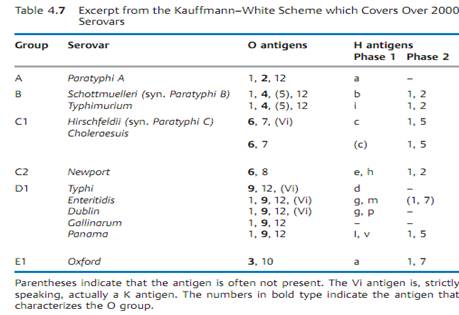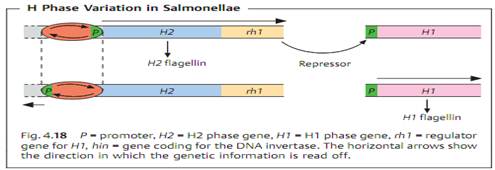


 النبات
النبات
 الحيوان
الحيوان
 الأحياء المجهرية
الأحياء المجهرية
 علم الأمراض
علم الأمراض
 التقانة الإحيائية
التقانة الإحيائية
 التقنية الحيوية المكروبية
التقنية الحيوية المكروبية
 التقنية الحياتية النانوية
التقنية الحياتية النانوية
 علم الأجنة
علم الأجنة
 الأحياء الجزيئي
الأحياء الجزيئي
 علم وظائف الأعضاء
علم وظائف الأعضاء
 الغدد
الغدد
 المضادات الحيوية
المضادات الحيوية|
Read More
Date: 15-3-2016
Date: 18-3-2016
Date: 1-3-2016
|
Salmonella
All salmonellae are classified in the species Salmonella enterica with seven subspecies. Nearly all human pathogen salmonellae are grouped under S. enterica, subsp. enterica. Salmonellae are further subclassified in over 2000 serovars based on their O and H antigens, which used to be (incorrectly) designated as species.
Typhoid salmonelloses are caused by the serovars typhi and paratyphi A, B, and C. The salmonellae are taken up orally and the invasion pathway is through the intestinal tract, from where they enter lymphatic tissue, first spreading lymphogenously, then hematogenously. A generalized septic clinical picture results. Human carriers are the only source of infection. Transmission is either direct by smear infection or indirect via food and drinking water. Anti-infective agents are required for therapy (ampicillin, cotrimoxazole, 4-quinolones). An active vaccine is available to protect against typhoid fever.
Enteric salmonelloses develop when pathogens are taken up with food. The primary infection source is usually livestock. These relatively frequent infections remain restricted to the gastrointestinal tract. Treatment with anti- infective agents is necessary in exceptional cases only.
Taxonomy. The salmonellae that cause significant human disease are classified in most countries under the taxon Salmonella enterica, subsp. enterica (synonymous with S. choleraesuis, subsp. choleraesuis). However, this nomenclature has still not been officially adopted by the Enterobacteriaceae Subcommittee. Salmonella enterica, spp. enterica includes over 2000 serovars, which were formerly (incorrectly) designated with species names. The serovars are capitalized to differentiate them from species.
The serovars are determined by O and H antigens. The Kauffman-White scheme is used to arrange them (see Table 4.7 for an excerpt).
This taxonomic arrangement classifies the serovars in groups characterized by certain O antigens (semibold). This results in a clinically and epidemiologically useful grouping, since certain serovars are responsible for typhoid salmonelloses and others for enteric salmonelloses. The serovars are determined by means of antisera in the slide agglutination test.


Pathogenesis and clinical pictures. Salmonellae are classified as either typhoid or enteric regarding the relevant clinical pictures and epidemiologies. It is not known why typhoid salmonellae only cause systemic disease in humans, whereas enteric salmonella infections occur in animals as well and are usually restricted to the intestinal tract.
- Typhoid salmonelloses. Attachment of typhoid salmonellae to cells of the jejunum (M cells). Invasion by means of endocytosis, transfer, and exocytosis. Phagocytosis in the subserosa by macrophages and translocation into the mesenteric lymph nodes. Proliferation occurs. Lymphogenous and hematogenous dissemination. Secondary foci in the spleen, liver, bone marrow, bile ducts, skin (roseola), Peyer's patches.
Manifest illness begins with fever, rising in stages throughout the first week to 39/40/41 °C. Further symptoms: stupor (typhos [greek] = fog), leukopenia, bradycardia, splenic swelling, abdominal roseola, beginning in the third week diarrhea, sometimes with intestinal bleeding due to ulceration of the Peyer's patches.
- Enteric salmonelloses. Attachment to enterocytes of the ileum and colon. Invasion of mucosa induced by invasin proteins on the surface of the salmonella cells. Persistence in epithelial cells, possibly in macrophages as well. Production of Salmonella enterotoxin. Local inflammation. Manifest illness usually begins suddenly with diarrhea and vomiting, accompanied in some cases by high fever. The symptoms abate after several days without specific therapy. In cases of massive diarrhea, symptoms may be observed that result from the loss of water and electrolytes (Table 4.8).
Diagnosis. The method of choice is detection of the pathogens in cultures. Selective indicator mediums are used to isolate salmonellae in stool. Identification is done using metabolic patterns . Serovar classification is determined with specific antisera in the slide agglutination test. Culturing requires at least two days. Typhoid salmonelloses can be diagnosed indirectly by measuring the titer of agglutinating antibodies to O and H antigens (according to Gruber-Widal). To provide conclusive proof the titer must rise by at least fourfold from blood sampled at disease onset to a sample taken at least one week later.
Therapy. Typhoid salmonelloses must be treated with anti-infective agents, whereas symptomatic treatment will suffice for enteric infections. Symptomatic treatment encompasses slowing down intestinal activity (e.g., with loperamide) and replacing fluid and electrolyte losses orally as required (WHO formula: 3.5 g NaCl, 2.5 g NaHCO3,1.5 g KCl, 20 g glucose per liter of water).

Eliminating the infection in chronic stool carriers of typhoid salmonellae,
2-5% of cases, presents a problem. Chronic carriers are defined as convales-cents who are still eliminating pathogens three months after the end of the manifest illness. The organisms usually persist in the scarified wall of the gallbladder. Success is sometimes achieved with high-dose administration of anti-infective agents, e.g., 4-quinolones or aminopenicillins. A cholecystectomy is required in refractory cases.
Epidemiology. The cases of typhoid salmonellosis seen in northern and central Europe are imported by travelers. Cases arise only sporadically or in form of an epidemic because of a chain of unfortunate circumstances. Humans are the only primary source of infection.
By contrast, enteric salmonelloses occur in this population both endemically and epidemically. Case counts are steadily increasing. Exact morbidity data are hard to come by due to the large numbers of unreported cases. Livestock represents the most important source of infection. The pathogens are transmitted to humans in food.
Prevention. The main method of effective prevention is to avoid exposure: this means clean drinking water, prevention of food contamination, avoidance of uncooked foods in countries where salmonellae occur frequently, disinfection of excreta containing salmonellae or from chronic carriers, etc. It is also important to report all cases to health authorities so that appropriate measures can be taken.
Typhoid fever vaccinations for travelers to endemic areas can best be done with the oral attenuated vaccine Virotif Ty 21a.



|
|
|
|
"عادة ليلية" قد تكون المفتاح للوقاية من الخرف
|
|
|
|
|
|
|
ممتص الصدمات: طريقة عمله وأهميته وأبرز علامات تلفه
|
|
|
|
|
|
|
المجمع العلمي للقرآن الكريم يقيم جلسة حوارية لطلبة جامعة الكوفة
|
|
|